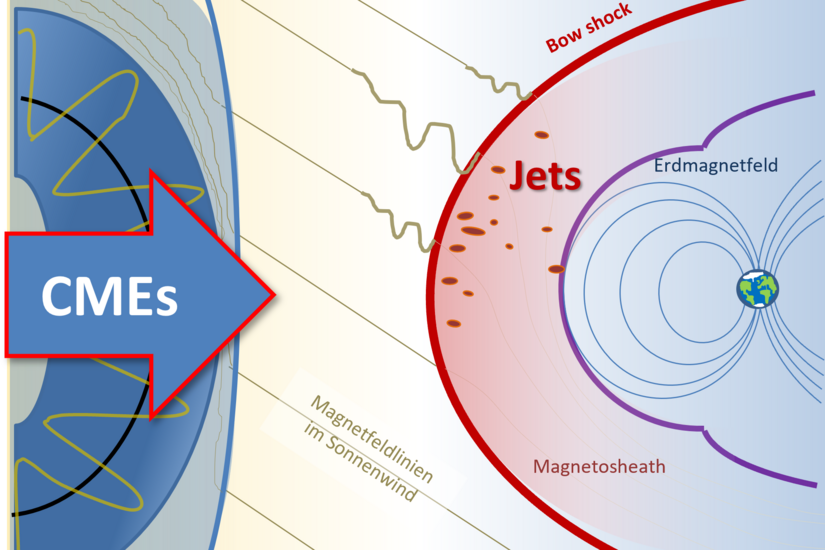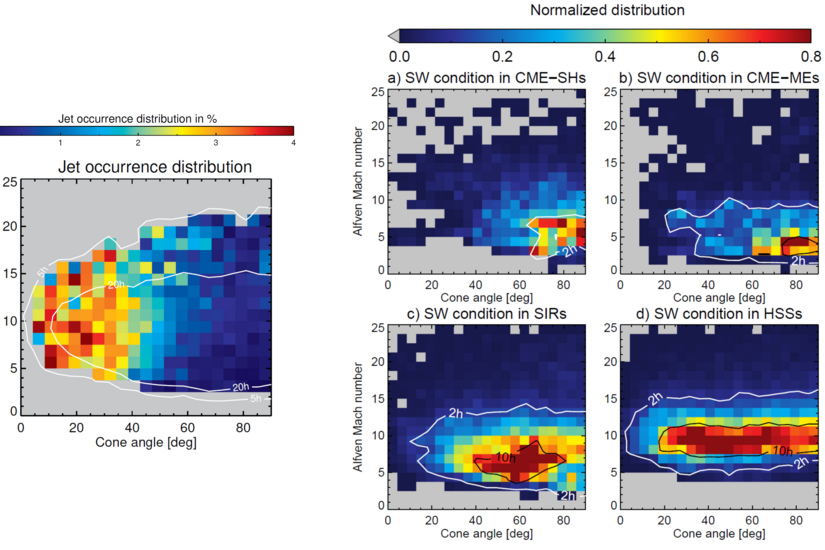The Earth’s magnetic field protects us from the constant flow of particles coming form the Sun, which we call the solar wind. The particles get suddenly decelerated when they meet the Earth’s magnetic field and form a thin, turbulent region between Earth and Sun: the magnetosheath. Within the magnetosheath, we regularly find faster or denser flows of particles, which we call jets. Jets get generated frequently and can impinge on our magnetic field, causing waves in the field lines and even geoeffective substorms.
The occurrence and formation of these jets are actively discussed in research. It has been shown that jets are mainly caused when solar wind plasma arrives at Earth very quickly with a high Mach number and with a certain orientation of the magnetic field inside it. In our current study, we demonstrated that large isolated magnetic plasma structures, such as coronal mass ejections (CMEs), lead to a reduction in jets. The reason is that magnetic field line angles with a different orientation often occur in them. In addition, the strong magnetic field in CMEs leads to lower Mach numbers, which also reduces the production of jets.
On the other hand, fast solar wind streams and associated compression regions (SIRs) offer ideal conditions for the formation of jets in the magnetosheath. They often have extended periods in which the magnetic field angle is aligned with the flow and continuously high velocities and Mach numbers, which promote jet formation. Figure 2 shows the probability of occurrence of jets as a function of Mach number and magnetic field line angle. This probability distribution is compared with the conditions found in CMEs and SIRs.
These results contribute to a better understanding of the statistical relationships between the solar wind, the structures contained therein, and how these structures cause secondary effects in near-Earth space. These findings stem from an active collaboration with the Institute of Physics in Graz, the TU Braunschweig, and the IWF Graz and open up further interdisciplinary research opportunities for a better understanding of Sun-Earth coupling (financially supported by the FWF in project P33285-N). The research results will be presented at the planned conference "Heliophysics in Europe" in October of this year.
Florian Koller, Ferdinand Plaschke, Manuela Temmer, Luis Preisser, Owen W. Roberts, Zoltan Vörös
Magnetosheath jet formation influenced by parameters in Solar Wind structures
Journal of Geophysical Research: Space Physics (accepted)
https://agupubs.onlinelibrary.wiley.com/doi/abs/10.1029/2023JA031339





